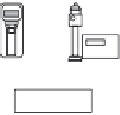Biomedical Engineering Reference
In-Depth Information
rectangular sticks. After production the nanocomposite test samples that contained
2 mass% CNTs were broken apart manually and sanded with P220 sanding paper
(68 µm grit size) to remove excess material until final dimensions were achieved.
Other parameters with regard to the sanding process are not given. During the sand-
ing process airborne particle number concentrations were measured using a CPC and
an optical particle counter (OPC) at two locations (adjacent to the sanding process
and in the breathing zone of the operator). Cena and Peters (2011) used the ratios of
the geometric mean concentration measured during the sanding process to the mea-
sured background concentrations (P/B ratio) as indices of the impact of the process.
They found that during the sanding process the nanoparticle number concentration
was negligibly elevated compared to the background concentration with a P/B ratio
of 1.04. Furthermore, they found that sanding epoxy containing CNTs may generate
micrometer-sized particles with embedded CNTs as shown by the corresponding
P/B ratio of 5.90 and electron microscopy analyses.
Huang et al. (2012) characterized the emission of the airborne particles from
epoxy resin test sticks with different CNT loadings and two commercial products
during a sanding process. An experimental setup consisting of a system to simulate
sanding and a system for sampling and monitoring airborne particles was developed
(Figure 12.4).
The experimental setup consisted of a sand blasting cabinet, which was housed
in a secondary clear plastic enclosure, both supplied with high efficiency particulate
airfilter (HEPA)-filtered air to maintain a low background concentration. A terminal
pump was used to extract a portion of the cabinet exhaust through a sampling mani-
fold from which the measurement devices, CPC, OPC, and scanning mobility particle
sizer (SMPS), received their sample flows. Inside the sand blasting cabinet a commer-
cial lathe was used where a disk plate with sanding paper was mounted to the spindle
Sanding simulation system
Sampling and monitoring system
Exhaust air
Plastic enclosure
Terminal
pump
Sampling
manifold
HEPA filter
Valve
Cabinet
with disc
sander
and lathe
Filter
CPC
SMPS
Sampling pump
HEPA filtered air mover
OPC
Pressure
gauge
#1
#2
Room air
R
oom air
AC volatege controller
FIGURE 12.4
Experimental setup used. (With kind permission from Springer
Science+Business Media:
J. Nanoparticle. Res
., Evaluation of airborne particle emissions
from commercial products containing carbon nanotubes, 14, 2012, 1-13, Huang, G. et al.)






















































Search WWH ::

Custom Search